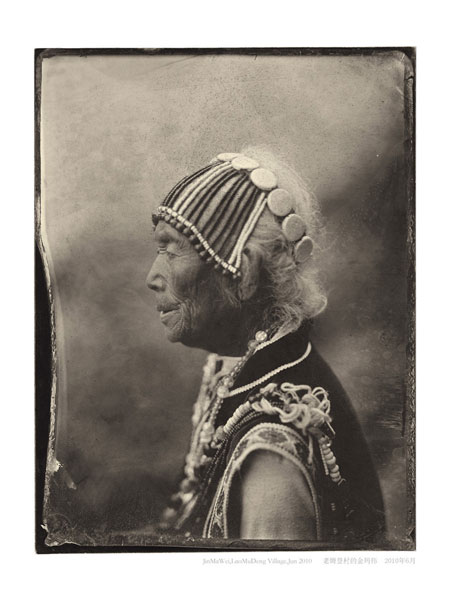
 |
|
"Jin Mawei" Lao Mu Deng Village, June 2010. Part of the "Simple Song" exhibit by Luo Dan. [Photo/China.org.cn] |
Chengdu-based photographer Luo Dan went digital early, adopting the technology as a photojournalist in the early 2000s. At the time, digital cameras were rare in China and his equipment attracted curious stares from onlookers.
Today, Luo works as an artist and his preferred photographic medium stands out for different reasons. He has turned the clock back 160 years, swapping his digital SLR for an antique large format camera and wet plate collodion.
Wet plate collodion rose to prominence in the 1850s as it produced outstanding detail in images and pioneered the printable negative. Its predecessor, the Daguerreotype, was a positive and not easily reproduced. Negatives remained a pillar of the photographic process for the next 150 years, as the medium evolved from wet glass to dry glass and finally, film.
Luo is one of the first prominent Chinese photographers to shoot with collodion wet plates in China. When the medium was in wide use during the mid-19th century, photography was still new to China and widely confined to the nation's small foreign community. Only a few Chinese photographers in Hong Kong set up portrait studios. Luo learned about this early photographic technology from foreign websites and historical materials in the Guangdong Museum.
Wet plate collodion plays a central role in his latest work "Simple Song," a portrait series exhibited at Shanghai's M97 gallery from the end of last October until late January. "Simple Song" depicts Christian ethnic minority villagers in Yunnan province's remote Nu River Valley. A Christian himself, Luo sought to use a vintage photographic method to capture the dignity and timeless nature of the villagers' agrarian existence.
The people Luo photographed for "Simple Song" belong to China's Lisu and Nu ethnic minorities. As of the 2010 national census, there are about 260,000 Lisu people and 30,000 Nu people residing in the Nujiang Lisu Autonomous Prefecture, which lies at the southern end of the Hengduan Mountain Range in western Yunnan.
While the Nu River Valley people are not materially wealthy, they are cheerful and brim with an inner clarity and light, Luo said. "Their way of life contrasts sharply with the materialism common in modern Chinese society."
Sharing a common faith with the Nu River Valley people, Luo easily assimilated into their communities. He spent May to October 2010 living in different villages throughout the region.
With many available subjects, the greatest challenge Luo faced was technical. Rather than memory cards or rolls of film, he had to carry fragile glass plates with him. Meanwhile, developing an image on a collodion plate is cumbersome. Once a photo is taken and prepared with light-sensitive chemicals, it must be brought to a darkroom and developed while still wet. The development process requires toxic chemicals like ether, silver nitrate and acetic acid. Assembling a portable darkroom filled with harmful substances requires some ingenuity on the photographer's part.